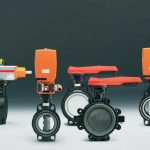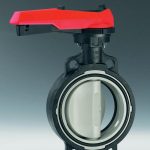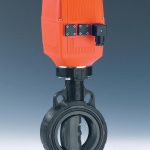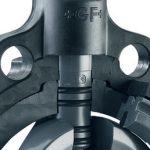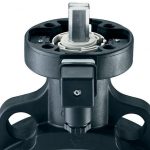GF Piping Systems launched the type 567 wafer-style butterfly valves and the type 568 lug-style butterfly valves for end installation in 2006. The two versions are available in time-tested plastic materials for sizes from DN 50 to DN 200. These valves replace the very successful type 367. The type 567 butterfly valves with the double eccentric operating principle seal when pressurised from both sides up to 10 bar.
Christian Neye
With metal and plastic piping systems in applications with up to 10 bar medium pressure, valve materials cannot be assigned as clearly as for ball valves. In plastic piping systems, butterfly valves made of the same material compete intensely with metal butterfly valves. In the latter, the parts in contact with the medium are coated, made of stainless steel or lined with elastomers (referred to as liners or sleeves). The liner has a sealing function in the passage, to the pipeline and to the exterior. The disc rotates around a centric shaft. This centric operating principle, which most plastic butterfly valves feature, is not adequate for all types of application. This is where double eccentricity comes in.
Steel butterfly valves are found in applications with pressures and temperatures so high that plastic solutions are no longer feasible in the long run. At 200 °C or 100 bar media pressure, elastomers are unsuitable as sealing elements. Such cases call for metal sealing with a double eccentric operating principle. The shaft is offset from the passage seal. The sealing circle of the pas-sage seal therefore does not intersect the rotating axis. When the butterfly valve is closed, the disc touches and compresses the passage seal only during the last 5 degrees or so of rotation. This is compulsory for metal seals with surface slip characteristics. The shaft is additionally offset from the centre of the disc. The rotating axis consequently does not intersect the pipeline axis. The result of this offset is that in an open valve the disc and the passage seal neither touch nor stick. The double eccentric operating principle makes great demands on the dimensional accuracy of the parts. This consequently entails numerous and costly machining operations, leading to a high price for metal butterfly valves. The injection moulding process used in plastics production achieves significantly greater accuracy than is generally the case with metal founding, eliminating the need for expensive machining in the manufacture of butterfly valves with a double eccentric operating principle. They therefore represent an attractive alternative to valves with a centric operating principle, even in applications up to 10 bar.
GF Piping Systems has successfully implemented this operating principle in the type 567 butterfly valve. The valve seals when pressurised from both sides up to 10 bar in accordance with ISO 9393–2. This bi-directional sealing is achieved thanks to the special design of the passage seal. The double eccentricity permits separate sealing elements to be used for the exterior seal and the passage seal. Double O-rings seal to the outside on both sides – a sealing method that has already been tried and tested in ball valves. A profile seal is installed in the passage. High-quality EPDM or FPM seals are standard. Other special sealing materials are available for a small additional charge.
Compatibility in every respect
The overall length of the butterfly valves complies with EN 558 (middle series), thus guaranteeing compatibility with most other providers. All parts that come into contact with the medium, such as the disc, inner housing and bushes, are manufactured from the relevant piping material (PVC-U, PVC-C, ABS, PP-H or PVDF). When a piping system is designed, the valve requires no special consideration regarding chemical resistance or pressure and temperature conditions. Moreover, permeation of the medium to the atmosphere is reduced compared to the liner versions. A sturdy housing made of fibre glass-reinforced PP-H provides stability and protection. The shaft does not contact the medium at all. A standardised interface to the actuating element – for example, a lever, a manual gearbox or an electric or pneumatic actuator – is a must today. The standardised mounting flange of the butterfly valve has a master F07 gauge for holes according to ISO 5210. The valve closes at 90° ±3°. It requires no subsequent adjustment, allowing easy actuator mounting or dismounting at a later time – without depressurising the valve.
All-inclusive
The requirements specified for an actuating lever are diverse. Corrosive environments call for an all-plastic lever. Georg Fischer has equipped its new, ergonomic levers with 5° indexing and 6 teeth that are always engaged. This rugged design can easily be converted into an infinitely variable, lockable lever. The butterfly valves are supplied with pneumatic and electric actuators. The pneumatic actuators (PA30 to PA90) have already been proven on the predecessor type 367. The electric actuators (EA31 and EA42) are more powerful versions of the EA21 and feature an all-plastic housing with IP 67 protection, automatic adaptation to the supply voltage, various monitoring functions such as motor current, cycle time, temperature, etc., worldwide suitability thanks to CE, UL and CSA certificates and emergency manual override as standard. Manual valves are easily retrofitted with an electric or pneumatic actuator. An interesting innovation is the electric position indicator integrated in the mounting flange – once again contributing to a very compact valve design. Microswitches with the IP 67 degree of protection detect the position of the shaft and therefore also the disc. The signal is not distorted by operating the manual valve. Users can choose between five different limit switch types.
Advantages at a glance
The plastic butterfly valves offer several advantages for operation and maintenance. The actuation torque of the double eccentric valves is up to 50 % lower than when the centric operating principle is used. Since actuation torque is largely dependent on internal pressure – usually between 2 and 6 bar for plastic piping systems – the valves have been designed especially for this pressure range. A reduced actuation torque also means less wear and tear and allows smaller and more cost-efficient actuators to be used. Valve discs made of coated grey or ductile cast iron are not resistant to abrasion or impact. Minute fissures in the coating or the liner cause the disc or housing to corrode rapidly. The valves may form a galvanic element with other metal parts in the piping system. This galvanic or inductive corrosion is difficult to control. A stainless steel disc and shaft can remedy the situation but are expensive. Plastic butterfly valves with shafts that do not come into contact with the medium have a clear advantage here. Valves with a double eccentric operating principle shut tightly at 90°; centric valves close at approximately 83° to 88°, depending on the design. Electrically or pneumatically actuated butterfly valves, in particular, require extensive adjustment each time the disc or actuator is replaced. This is no longer the case with the butterfly valves from GF Piping Systems. The housing, shaft and disc of these valves are indexed so that incorrect mounting is virtually impossible. This increases safety during maintenance work. The butterfly valves are available for intermediate (type 567 – wafer-style) or end (type 568 – lug-style) installations. The housing of plastic butterfly valves with metal inserts for end installations bends very quickly under the tightening torque of the screws, which is frequently too high. This can lead to leakage or even fracture of the housing. The type 567 and type 568 butterfly valves avoid this problem. Both valve types have the same inner workings. The GGG40.3 ductile cast iron housing of the valve for end installation is coated with epoxy powder. Special O-rings with a broader contact face provide a reliable seal to the pipeline and ensure easy, leak-free assembly. Displacement, falling out and turning down are consequently impossible. The number of approvals is rising steadily and an expansion of the size range to include DN 250 and DN 300 is planned. The use of higher quality shaft materials, such as titanium, has already been successfully realised.
cpp 430
Georg Fischer
Achemasia 2007
Share:



